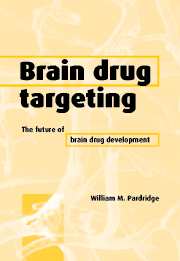Book contents
- Frontmatter
- Contents
- Preface
- List of abbreviations
- 1 Drug targeting, drug discovery, and brain drug development
- 2 Invasive brain drug delivery
- 3 Lipid-mediated transport and carrier-mediated transport of small molecules
- 4 Receptor-mediated transcytosis of peptides
- 5 Vector discovery: genetically engineered Trojan horses for drug targeting
- 6 Linker strategies: the engineering of multifunctional drug formulations
- 7 Protein neurotherapeutics and peptide radiopharmaceuticals
- 8 Antisense neurotherapeutics and imaging gene expression in vivo
- 9 Gene therapy of the brain
- 10 Blood–brain barrier genomics
- References
- Index
- Plate section
1 - Drug targeting, drug discovery, and brain drug development
Published online by Cambridge University Press: 08 January 2010
- Frontmatter
- Contents
- Preface
- List of abbreviations
- 1 Drug targeting, drug discovery, and brain drug development
- 2 Invasive brain drug delivery
- 3 Lipid-mediated transport and carrier-mediated transport of small molecules
- 4 Receptor-mediated transcytosis of peptides
- 5 Vector discovery: genetically engineered Trojan horses for drug targeting
- 6 Linker strategies: the engineering of multifunctional drug formulations
- 7 Protein neurotherapeutics and peptide radiopharmaceuticals
- 8 Antisense neurotherapeutics and imaging gene expression in vivo
- 9 Gene therapy of the brain
- 10 Blood–brain barrier genomics
- References
- Index
- Plate section
Summary
The brain of all vertebrates is protected from substances in the blood by the blood–brain barrier (BBB). Owing to the presence of the BBB, >98% of new drugs discovered for the central nervous system (CNS) do not enter the brain following systemic administration. Twentieth-century CNS drug development, like drug development in general, relied almost exclusively on small molecule pharmaceuticals, as it was generally believed that small molecules cross the BBB. In fact, most small molecules do not cross the BBB, as reviewed in Chapter 3. The few small molecules that did cross the BBB enabled twentieth-century CNS drug development to focus on small molecule drug discovery without a parallel program in CNS drug targeting. The sole reliance on small molecules will change in the twenty-first century as large molecule pharmaceuticals are developed. Large molecule drugs are peptides, recombinant proteins, monoclonal antibodies, antisense drugs, and gene edicines. Since these large molecule drugs do not cross the BBB, it will not be possible to develop large molecules as CNS pharmaceuticals unless there is a parallel development of BBB drug-targeting technology. The future of brain drug development will, therefore, be limited by progress in brain drug targeting.
The driving force in the discovery and development of large molecule drugs is the emerging new science of genomics (Figure 1.1). The application of genomics technologies and gene microarrays, in parallel with the availability of the complete sequence of the human genome, will lead to the discovery of thousands of new gene targets, and thousands of new secreted proteins.
- Type
- Chapter
- Information
- Brain Drug TargetingThe Future of Brain Drug Development, pp. 1 - 12Publisher: Cambridge University PressPrint publication year: 2001
- 14
- Cited by



